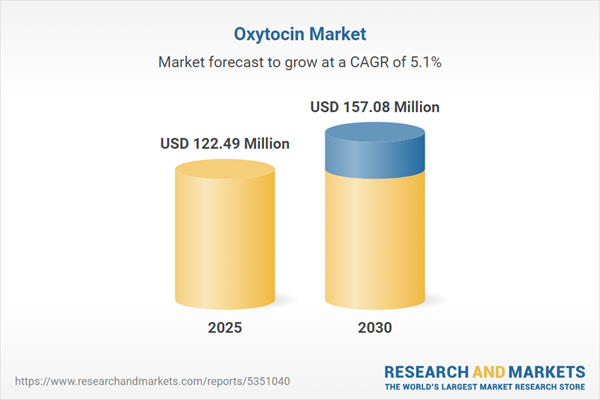The global oxytocin market is experiencing steady growth, driven by the rising prevalence of childbirth complications and increasing hospital-based births worldwide. Oxytocin, a hormone used to induce labor, strengthen uterine contractions, and control postpartum bleeding, is critical in addressing these complications. North America dominates the market due to its advanced healthcare infrastructure and high awareness of pregnancy-related issues, while the Asia-Pacific region is witnessing rapid growth due to improved access to medical facilities. However, partial bans on oxytocin in various countries pose a significant challenge to market expansion.
Market Drivers
The primary driver of the oxytocin market is the increasing incidence of childbirth complications, which necessitates the use of oxytocin to manage labor and postpartum challenges. Conditions such as eclampsia, cardiomyopathy, embolism, sepsis, and respiratory distress are becoming more prevalent, heightening the demand for oxytocin to induce or support labor and control bleeding. The growing trend of hospital births, facilitated by improved access to healthcare facilities, further boosts market growth. As more women opt for hospital deliveries, the need for oxytocin to address complications during childbirth continues to rise. This trend is particularly pronounced in developing regions, where healthcare infrastructure is expanding, enabling greater access to medical interventions.Market Segmentation
The oxytocin market can be segmented by application (labor induction, postpartum hemorrhage control, and others), end-user (hospitals, clinics, and others), and geography (North America, South America, Europe, Middle East and Africa, Asia-Pacific). These segments reflect the diverse clinical applications and regional dynamics driving the market, with hospitals being the primary end-users due to the controlled administration of oxytocin in medical settings.Geographical Outlook
North America holds a significant market share, attributed to its robust healthcare system, high awareness of childbirth complications, and widespread adoption of oxytocin in clinical settings. The region’s advanced medical infrastructure ensures effective diagnosis and management of pregnancy-related issues, supporting market dominance. Conversely, the Asia-Pacific region is emerging as a high-growth market, driven by increasing access to medical facilities for pregnant women and rising healthcare investments. Countries in this region are witnessing a surge in hospital births, which directly correlates with higher oxytocin usage.Challenges
The market faces a notable restraint in the form of partial bans on oxytocin in several countries, driven by concerns over misuse or overuse in non-medical settings. These regulatory restrictions could limit market growth by reducing availability in certain regions. Additionally, ensuring safe and controlled administration of oxytocin remains a challenge, particularly in areas with less developed healthcare systems.Competitive Landscape
Key players in the oxytocin market are focusing on strategies such as product development, regulatory compliance, and partnerships to strengthen their market position. Companies are investing in research to enhance the safety and efficacy of oxytocin formulations, while also navigating regional regulations to ensure market access.The oxytocin market is poised for steady growth, propelled by rising childbirth complications and increased hospital births. North America’s dominance and Asia-Pacific’s rapid growth highlight the market’s regional dynamics. However, regulatory bans pose challenges that require strategic navigation by industry players. Continued focus on safe, effective oxytocin use and healthcare access will drive market expansion during the forecast period.
Key Benefits of this Report:
- Insightful Analysis: Gain detailed market insights covering major as well as emerging geographical regions, focusing on customer segments, government policies and socio-economic factors, consumer preferences, industry verticals, and other sub-segments.
- Competitive Landscape: Understand the strategic maneuvers employed by key players globally to understand possible market penetration with the correct strategy.
- Market Drivers & Future Trends: Explore the dynamic factors and pivotal market trends and how they will shape future market developments.
- Actionable Recommendations: Utilize the insights to exercise strategic decisions to uncover new business streams and revenues in a dynamic environment.
- Caters to a Wide Audience: Beneficial and cost-effective for startups, research institutions, consultants, SMEs, and large enterprises.
What do businesses use our reports for?
Industry and Market Insights, Opportunity Assessment, Product Demand Forecasting, Market Entry Strategy, Geographical Expansion, Capital Investment Decisions, Regulatory Framework & Implications, New Product Development, and Competitive Intelligence.Report Coverage:
- Historical data from 2022 to 2024 & forecast data from 2025 to 2030
- Growth Opportunities, Challenges, Supply Chain Outlook, Regulatory Framework, and Trend Analysis
- Competitive Positioning, Strategies, and Market Share Analysis
- Revenue Growth and Forecast Assessment of segments and regions including countries
- Company Profiling (Strategies, Products, Financial Information, and Key Developments among others)
Segmentation
- By Indication
- Antepartum Hemorrhage
- Postpartum Hemorrhage (PPH)
- Labor Induction
- Uterine Atony
- Miscarriage Management
- Lactation Support
- By Dosage Form
- Injection
- Nasal Spray
- Other Forms
- By End-User
- Hospitals
- Maternity Clinics
- Home Birth Settings
- By Distribution Channel
- Hospital Pharmacies
- Retail Pharmacies
- Online Pharmacies
- Others
- By Geography
- North America
- USA
- Canada
- Mexico
- South America
- Brazil
- Argentina
- Others
- Europe
- United Kingdom
- Germany
- France
- Spain
- Others
- Middle East and Africa
- Saudi Arabia
- UAE
- Others
- Asia-Pacific
- China
- Japan
- India
- South Korea
- Taiwan
- Others
- North America
Table of Contents
Companies Mentioned
- Pfizer Inc.
- Merck & Co., Inc.
- GlaxoSmithKline plc
- Grindeks
- Taj Pharmaceuticals Ltd.
- Karnataka Antibiotics & Pharmaceuticals Ltd. (KAPL)
Table Information
| Report Attribute | Details |
|---|---|
| No. of Pages | 145 |
| Published | November 2025 |
| Forecast Period | 2025 - 2030 |
| Estimated Market Value ( USD | $ 122.49 Million |
| Forecasted Market Value ( USD | $ 157.08 Million |
| Compound Annual Growth Rate | 5.1% |
| Regions Covered | Global |
| No. of Companies Mentioned | 6 |









